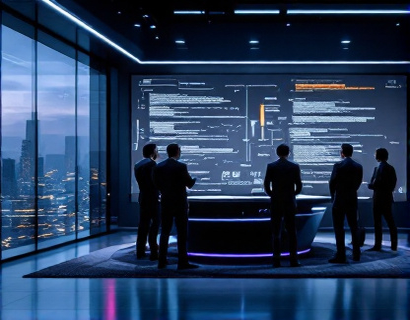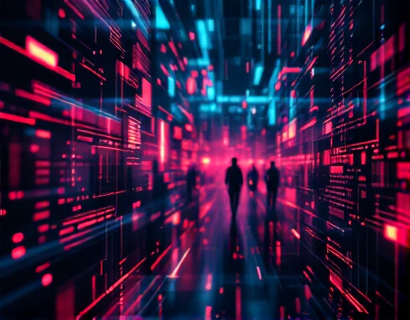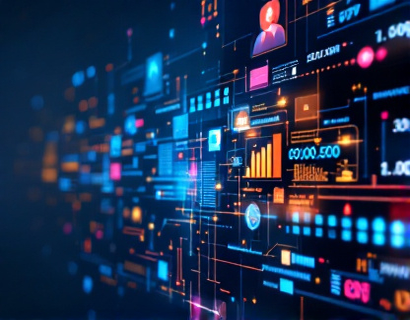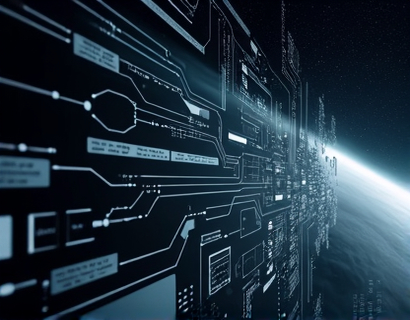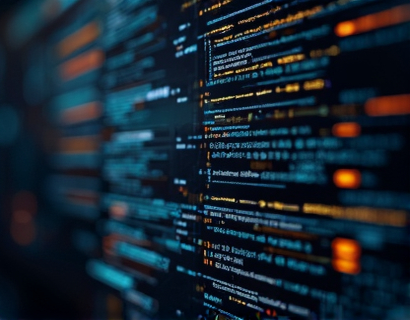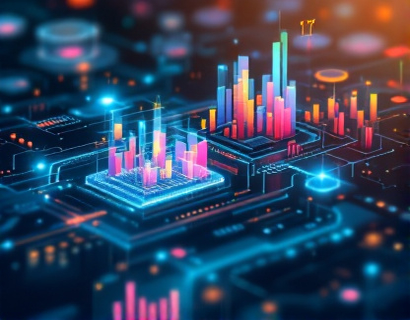Next-Gen Ucosystem Innovations: Transforming Applications with AI and Crypto Synergy
The intersection of artificial intelligence and cryptocurrency is giving birth to a new era of technological advancements, redefining how we interact with digital applications and services. This fusion, often referred to as tech fusion, is creating a robust ecosystem where traditional boundaries are blurred, and innovative solutions emerge. The synergy between AI and crypto is not just a trend but a transformative force that is reshaping the digital landscape. This article explores the next generation of tech-driven applications that leverage the power of both AI and cryptocurrency, offering insights into how these innovations are revolutionizing user experiences and digital interactions.
The crypto space has always been at the forefront of adopting and integrating cutting-edge technologies. The decentralized nature of cryptocurrencies, combined with the computational power of blockchain, provides a unique foundation for AI applications. AI, with its ability to process vast amounts of data, learn from patterns, and make predictions, complements the transparency and security offered by blockchain technology. This combination opens up a myriad of possibilities for developing applications that are not only intelligent but also secure and trustworthy.
AI-Driven Cryptocurrency Applications
One of the most significant areas where AI and crypto intersect is in the development of advanced cryptocurrency applications. These applications utilize AI to enhance various aspects of crypto trading, management, and security. For instance, AI-powered trading bots can analyze market data in real-time, identify trends, and execute trades with minimal human intervention. These bots use machine learning algorithms to adapt to market conditions, improving their performance over time. This not only increases the efficiency of trading but also opens up opportunities for novice traders who may not have the expertise to navigate complex markets manually.
Another application is in the realm of cryptocurrency wallets and security. AI can be used to detect and prevent fraudulent activities by analyzing transaction patterns and identifying anomalies. Machine learning models can be trained to recognize suspicious behavior and alert users or automatically block transactions, enhancing the overall security of crypto assets. This is particularly crucial as the crypto market continues to grow and attract more users, making it a prime target for cybercriminals.
Decentralized Finance (DeFi) and AI
Decentralized Finance, or DeFi, is a revolutionary financial system built on blockchain technology that aims to provide financial services without traditional intermediaries. AI plays a pivotal role in enhancing DeFi applications by optimizing processes, reducing risks, and improving user experiences. For example, AI can be used to create smart contracts that automatically execute transactions based on predefined conditions, ensuring transparency and reducing the risk of human error. These smart contracts can be further enhanced with AI to adapt to changing market conditions and user needs, making DeFi more dynamic and responsive.
AI-driven risk assessment tools are also transforming the DeFi landscape. By analyzing vast amounts of data, AI can evaluate the creditworthiness of users and the risk associated with various financial instruments. This enables DeFi platforms to offer more personalized and secure financial products, such as decentralized loans and insurance policies. The ability to make data-driven decisions in real-time enhances the efficiency and reliability of DeFi services, attracting more users and investors to the ecosystem.
Crypto-Based AI Platforms
The integration of AI and crypto has led to the emergence of crypto-based AI platforms that leverage blockchain for decentralized AI computing. These platforms allow developers to build and deploy AI models using decentralized resources, ensuring data privacy and security. By utilizing the computational power of the blockchain network, these platforms can process large datasets efficiently without the need for centralized servers. This not only reduces costs but also mitigates the risk of data breaches and censorship.
One notable example is the use of blockchain for federated learning, a machine learning technique where models are trained across multiple decentralized devices or servers holding local data samples, without exchanging them. This approach ensures that sensitive data remains on the device, enhancing privacy. AI platforms that support federated learning on blockchain can develop more robust and generalized models, benefiting various industries such as healthcare, finance, and autonomous vehicles.
Tokenized AI Models and Marketplaces
The concept of tokenizing AI models is another innovative application of AI and crypto synergy. By tokenizing AI models, developers can create tradable assets that represent ownership or usage rights to specific AI capabilities. This tokenization enables a new market where AI models can be bought, sold, and traded like any other digital asset. Tokenized AI models can be used in various applications, from customizing AI services to creating collaborative AI projects where multiple parties contribute and benefit from shared resources.
Crypto-powered marketplaces are emerging to facilitate the buying and selling of these tokenized AI models. These platforms use blockchain to ensure transparency, traceability, and security in transactions. Users can browse a wide range of AI models, from image recognition to natural language processing, and purchase the ones that best suit their needs. The use of smart contracts in these marketplaces automates the payment and access control processes, making the entire transaction seamless and trustless.
AI-Enhanced Crypto Analytics
AI is also revolutionizing crypto analytics by providing deeper insights and more accurate predictions. Traditional analytics methods often struggle to handle the vast and complex datasets generated by crypto markets. AI algorithms, particularly those based on deep learning and natural language processing, can analyze news articles, social media posts, and other textual data to gauge market sentiment and predict price movements. This sentiment analysis, combined with technical and fundamental data, enables more informed decision-making for investors and traders.
Moreover, AI can help in identifying patterns and correlations that are not immediately apparent to human analysts. By processing historical data and real-time market information, AI models can forecast market trends and identify potential trading opportunities. This not only enhances the efficiency of crypto trading but also democratizes access to sophisticated analytical tools, empowering a broader range of users to participate in the market.
Challenges and Considerations
While the synergy between AI and crypto offers numerous benefits, it also presents several challenges that need to be addressed. One of the primary concerns is the regulatory landscape. The decentralized and borderless nature of crypto, combined with the complex and often opaque nature of AI algorithms, poses significant regulatory challenges. Ensuring compliance with existing laws and regulations while fostering innovation requires a balanced and forward-thinking approach from policymakers.
Another challenge is the technical complexity involved in integrating AI with blockchain technology. Developing robust and scalable solutions that can handle the high transaction volumes and computational demands of both AI and crypto requires significant expertise and resources. Additionally, ensuring the interoperability of different AI and crypto systems is crucial for creating a seamless and integrated ecosystem.
Security remains a paramount concern as well. While AI can enhance security measures, it can also introduce new vulnerabilities if not properly implemented. For instance, AI models can be susceptible to adversarial attacks, where malicious actors manipulate input data to produce incorrect outputs. Ensuring the robustness and resilience of AI-driven crypto applications requires continuous monitoring, testing, and updating of security protocols.
Future Prospects
Looking ahead, the fusion of AI and crypto is poised to drive even more innovative applications and transformative experiences. One area of potential growth is in the development of AI-powered virtual assistants for crypto management. These assistants can provide personalized recommendations, monitor portfolio performance, and execute trades based on user preferences and market conditions. The integration of voice and gesture recognition technologies can make these assistants even more user-friendly and accessible.
Another exciting frontier is the use of AI in creating decentralized autonomous organizations (DAOs) that combine the power of AI with the governance models of DAOs. These organizations can leverage AI for decision-making, resource allocation, and strategic planning, making them more efficient and adaptive to changing environments. The transparency and community-driven nature of DAOs, enhanced by AI, can lead to more equitable and inclusive financial systems.
Furthermore, the convergence of AI and crypto can drive advancements in other technologies such as the Internet of Things (IoT) and edge computing. AI can optimize the vast amounts of data generated by IoT devices, while blockchain can ensure the secure and decentralized storage and processing of this data. This synergy can lead to more intelligent and autonomous systems that enhance various aspects of daily life, from smart homes to industrial automation.
In conclusion, the fusion of AI and crypto is opening up a new realm of possibilities for tech-driven applications. By leveraging the strengths of both technologies, developers and innovators can create more intelligent, secure, and user-friendly solutions that redefine digital interactions and experiences. As the ecosystem continues to evolve, it is essential to address the challenges and ensure that the benefits of this synergy are realized by all stakeholders in the crypto and AI domains.




